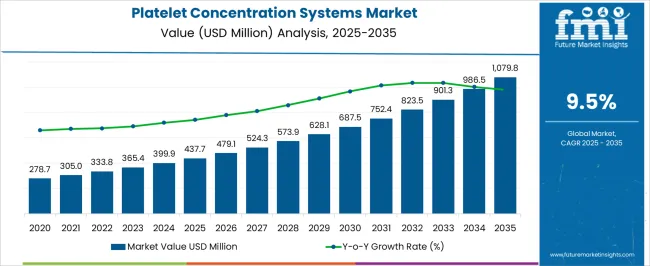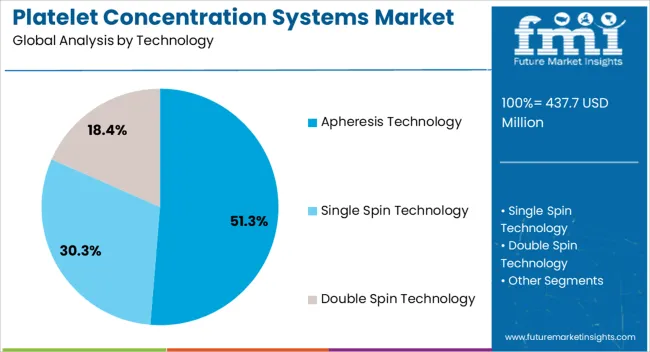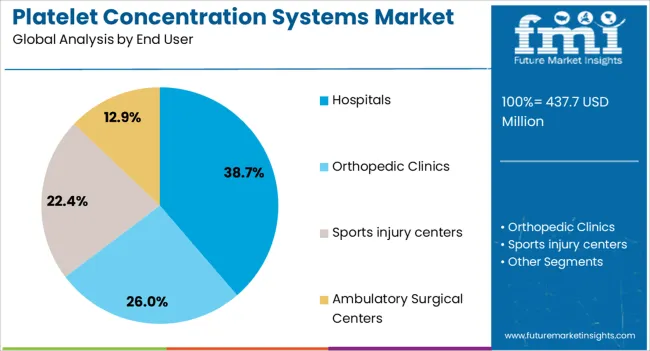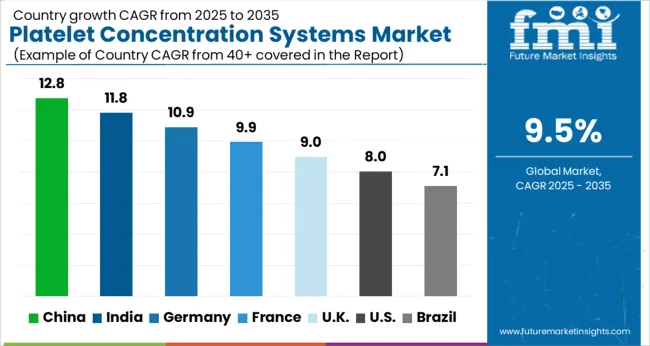The Platelet Concentration Systems Market is estimated to be valued at USD 437.7 million in 2025 and is projected to reach USD 1079.8 million by 2035, registering a compound annual growth rate (CAGR) of 9.5% over the forecast period.

| Metric | Value |
|---|---|
| Platelet Concentration Systems Market Estimated Value in (2025 E) | USD 437.7 million |
| Platelet Concentration Systems Market Forecast Value in (2035 F) | USD 1079.8 million |
| Forecast CAGR (2025 to 2035) | 9.5% |
The platelet concentration systems market is witnessing steady expansion, supported by the rising adoption of regenerative medicine and the growing prevalence of orthopedic, cardiovascular, and cosmetic procedures. The ability of platelet-rich plasma to accelerate healing, improve tissue regeneration, and reduce recovery time is increasing demand across both developed and emerging economies. Technological advancements in platelet separation and concentration methods are improving the efficiency and consistency of clinical outcomes, thereby strengthening market penetration.
Increasing awareness among patients regarding minimally invasive treatment options is further influencing adoption, particularly in sports medicine and dentistry. Hospitals and clinics are expanding the use of platelet concentration systems in routine procedures, reflecting broader acceptance within mainstream medical practice.
Rising investments in research for new therapeutic applications, including wound healing and dermatology, are also expanding the scope of utilization As healthcare systems continue to focus on improving recovery outcomes while reducing overall costs, platelet concentration systems are positioned to play an increasingly important role in both specialized and general medical applications, ensuring strong market growth over the coming years.
The platelet concentration systems market is segmented by technology, end user, and geographic regions. By technology, platelet concentration systems market is divided into Apheresis Technology, Single Spin Technology, and Double Spin Technology. In terms of end user, platelet concentration systems market is classified into Hospitals, Orthopedic Clinics, Sports injury centers, and Ambulatory Surgical Centers. Regionally, the platelet concentration systems industry is classified into North America, Latin America, Western Europe, Eastern Europe, Balkan & Baltic Countries, Russia & Belarus, Central Asia, East Asia, South Asia & Pacific, and the Middle East & Africa.

The apheresis technology segment is projected to account for 51.3% of the platelet concentration systems market revenue share in 2025, making it the leading technology category. Its dominance is being driven by the ability to deliver high-quality platelet-rich plasma with consistent concentration levels, which improves treatment efficacy across multiple therapeutic areas. Apheresis technology offers precision in separating platelets from other blood components, ensuring higher purity and reducing the risk of contamination.
Hospitals and clinics are increasingly adopting this method due to its ability to produce platelet concentrates in larger volumes, making it suitable for high-demand settings such as orthopedic surgeries and wound management. Advances in automated apheresis systems have simplified procedures, reduced processing time, and minimized human error, further supporting adoption.
Growing patient preference for treatments with proven clinical outcomes has reinforced confidence in apheresis-based systems As demand rises for personalized and efficient regenerative therapies, the reliability and scalability of apheresis technology are expected to maintain its leading market position over the forecast period.

The hospitals segment is anticipated to hold 38.7% of the platelet concentration systems market revenue share in 2025, positioning it as the leading end-user category. This leadership is being reinforced by the large volume of surgical procedures, trauma care, and therapeutic interventions performed within hospital settings, which generate strong demand for platelet concentration systems. Hospitals are increasingly integrating platelet-rich plasma therapies into orthopedic, cardiovascular, dental, and cosmetic treatments, reflecting broader clinical acceptance.
The presence of advanced medical infrastructure, trained professionals, and established patient care protocols ensures effective utilization of these systems. Additionally, hospitals benefit from the availability of reimbursement pathways in many regions, which encourages both physicians and patients to adopt platelet-based treatments. Rising investments in hospital-based regenerative medicine programs are further accelerating demand.
The segment’s growth is also being supported by hospitals’ ability to handle high patient throughput, enabling efficient use of platelet concentration systems in both elective and emergency procedures As patient awareness of regenerative therapies continues to grow, hospitals are expected to remain the primary centers for adoption, driving sustained leadership in the market.
Platelet rich plasma (PRP) is a regenerative injection therapy which stimulate body's natural healing process. Platelet Rich Plasma is a plasma fraction of autologous blood which has been enriched with platelets by specialized equipment.
Platelet-rich plasma is a non-surgical alternative to potential cure areas, such as orthopedics, sports medicine, dentistry, ENT, neurosurgery, ophthalmology, urology, and wound healing; as well as cosmetic, cardiothoracic, and maxillofacial surgery. Platelet concentration systems are designed for safe and rapid preparation of platelet rich plasma at the point of care from a small amount of patient's blood sample.
Such concentrated systems offers high platelet yield through centrifugal action which preserves the fragile buffy coat. This buffy coat is suspended in the volume of plasma and delivered back to the patient. Depending on the system used for the preparation of PRP the concentration of platelets may range from four to eight times.
In addition many systems available in the market now a days also allow collection of platelet poor plasma which can be delivered to the patients as an autologous fibrin product for topical homeostasis. The market for platelet concentration systems is expected to grow at a good pace attributed to increasing technological advancements and increasing application of PRP therapy in sports medicine.
Foremost drivers for platelet concentration systems include rising prevalence of musculoskeletal injuries with rising application of PRP therapy in sports medicine. According to the European Injury Data Base, approximately 4.5 million people aged 15 years and above are treated in EU hospitals for sports injury annually.
Also introduction of technologically advanced platelet concentration systems in the preparation of autologous blood concentrate would enhance the rapid penetration of these devices in the forthcoming years. For instance, PEAK PRP System (DePuy) prepares highly concentrated 3 ml of PRP from 27 ml of whole blood in only two and half minutes.
However, strong competition from local manufactures may affect the overall market growth of platelet concentration systems in the near future.
Currently, North America has the largest market share in the use of platelet concentration systems attributed to increasing prevalence of sports related injuries followed by Europe and Asia Pacific. European Commission states that, in a year, about 15-20% of primary care consultation in Europe is for musculoskeletal injuries.
However, platelet rich plasma therapy is an attractive and promising alternative to surgery, for treating musculoskeletal injuries such as tennis elbow, achilles tendinopathy and plantar fasciitis, by promoting safe and effective wound healing.
However, with development of sophisticated R&D infrastructure in emerging region such as APAC, is expected to gain traction in the forthcoming years. Other factors expected to have the prominent impact on the growth of platelet concentration system are increasing patient awareness and affordability levels and regulatory harmonization.

| Country | CAGR |
|---|---|
| China | 12.8% |
| India | 11.8% |
| Germany | 10.9% |
| France | 9.9% |
| UK | 9.0% |
| USA | 8.0% |
| Brazil | 7.1% |
The Platelet Concentration Systems Market is expected to register a CAGR of 9.5% during the forecast period, exhibiting varied country level momentum. China leads with the highest CAGR of 12.8%, followed by India at 11.8%. Developed markets such as Germany, France, and the UK continue to expand steadily, while the USA is likely to grow at consistent rates. Brazil posts the lowest CAGR at 7.1%, yet still underscores a broadly positive trajectory for the global Platelet Concentration Systems Market. In 2024, Germany held a dominant revenue in the Western Europe market and is expected to grow with a CAGR of 10.9%. The USA Platelet Concentration Systems Market is estimated to be valued at USD 150.4 million in 2025 and is anticipated to reach a valuation of USD 325.7 million by 2035. Sales are projected to rise at a CAGR of 8.0% over the forecast period between 2025 and 2035. While Japan and South Korea markets are estimated to be valued at USD 22.1 million and USD 13.9 million respectively in 2025.
| Item | Value |
|---|---|
| Quantitative Units | USD 437.7 Million |
| Technology | Apheresis Technology, Single Spin Technology, and Double Spin Technology |
| End User | Hospitals, Orthopedic Clinics, Sports injury centers, and Ambulatory Surgical Centers |
| Regions Covered | North America, Europe, Asia-Pacific, Latin America, Middle East & Africa |
| Country Covered | United States, Canada, Germany, France, United Kingdom, China, Japan, India, Brazil, South Africa |
| Key Companies Profiled | Arthrex, Inc., Stryker Corporation, Johnson & Johnson, Zimmer Biomet Holdings Inc., Terumo Corporation, Arteriocyte Medical Systems, Inc., Exactech Inc., Harvest Technologies Corp., Nuo Therapeutics, Inc., Haemonetics Corporation, Fresenius SE & Co. KGaA, Macopharma, BioIVT, Stago, and Pall Corporation |
The global platelet concentration systems market is estimated to be valued at USD 437.7 million in 2025.
The market size for the platelet concentration systems market is projected to reach USD 1,079.8 million by 2035.
The platelet concentration systems market is expected to grow at a 9.5% CAGR between 2025 and 2035.
The key product types in platelet concentration systems market are apheresis technology, single spin technology and double spin technology.
In terms of end user, hospitals segment to command 38.7% share in the platelet concentration systems market in 2025.
Explore Similar Insights

Thank you!
You will receive an email from our Business Development Manager. Please be sure to check your SPAM/JUNK folder too.
Chat With
MaRIA